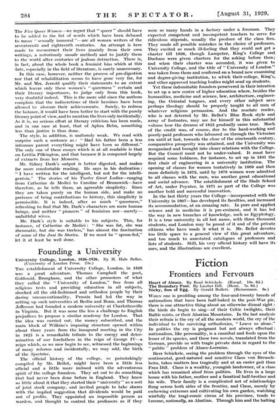Founding a University
University College, London, 1826-1926. By H. Hale Bellot. (University of ,London Press. 25s.) TI1E establishment of University College, London, in 1826 was a great adventure. Thomas Campbell the poet,
Goldsmid, Brougham, and the other promoters of what they called the "University of London," free from all religious tests and providing education in all subjects, shocked all the old-fashioned and orthodox people by their daring unconventionality. Prussia had led the way in
setting up such universities at Berlin and Bonn, and Thomas Jefferson had founded a modern university at Charlottesville in Virginia. But it was none the less a challenge to English prejudices to propose a similar academy for London. That the idea was carried out, the money subscribed, and the main block of Wilkins's imposing structure opened within about three years from the -inaugural meeting in the City in 1825 is a remarkable tribute to the energy and deter- mination of our forefathers in the reign of George IV—a reign which, as we now begin to see, witnessed the begilmings of many reforms and incidentally, we may add, the birth of the Spectator.
The official history of the college, so painstakingly compiled by Mr. Bellot, might have been a little less official and a little more imbued with the adventurous spirit of the college founders. They set out to do something that had never been done before in England. They knew so little about it that they started their " university " as a sort of joint stock company, and invited people to take shares with the implied suggestion that dividends would be paid out of profits. They appointed an impossible person as warden, and thought to control the professors as if they
were so many hands in a factory under a foreman. They expected competent and incompetent teachers to serve for ridiculous stipends, usually the produce of the class fees. They made all possible mistakes in the choice of professors. They excited so much ill-feeling that they could not get a charter till 1836, though Lampeter, King's College and Durham were given charters for the asking before then; and when their charter was accorded, it was given to University College, and the title of "University of London" was taken from them and conferred on a brand new examining and degree-giving institution, to which their college, King's, and other approved teaching bodies might send up students.
Yet these indomitable founders persevered in their intention to set up a new centre of higher education where, besides the humanities, medicine and science, law, architecture, engineer- ing, the Oriental tongues, and every other subject save perhaps theology should be properly taught to all men of whatever religious persuasion. And the resolute reader, who is not deterred by Mr. Bellot's Blue Book style and array of footnotes, may see for himself in this substantial volume how the dreams of 1825 gradually came true. Much of the credit was, of course, due to the hard-working and poorly-paid professors who laboured on through the Victorian era until at last, towards the close of the nineteenth century, comparative prosperity was attained, and the University was reorganized and brought into closer relations with the College. But the Council must not be under-valued. It must have required some boldness, for instance, to set up in 1841 the first chair of engineering in a university institution. The opening of classes for women tentatively in 1869 and then more definitely in 1878, until by 1878 women were admitted to all classes with the men, was another great educational and social advance. The establishment of the Slade School of Art, under Poynter, in 1871 as part of the College was another bold and successful innovation.
In the last thirty years the College—incorporated with the University in 1907—has developed its faculties, and increased its accommodation, at an amazing rate. In pure and applied science and in medicine it is pre-eminent, and it has led the way in new branches of knowledge, such as Egyptology. It is a true university in all but name, with three thousand students, and London may be proud of it and of the private citizens who have made it what it is. Mr. Bellot devotes too little space to a general view of this great adventure, and too much to annotated catalogues of professors and lists of students. Still, his very official history will have its uses, and the illustrations are excellent.
































 Previous page
Previous page